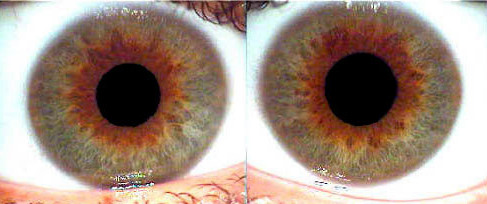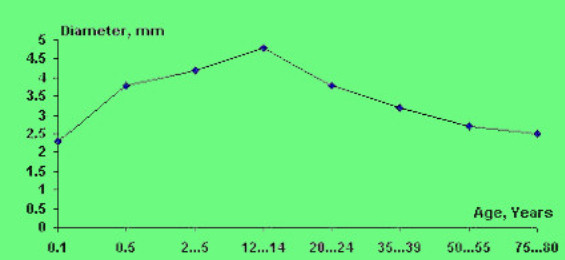Color of the pupil
Normal Black Color
The color of the pupil depends on the state of the crystalline and anterior chamber of the eye. In turn, changes of the crystalline and anterior chamber are the consequences of the pathology of an organism’s functional systems (endocrine, vascular and so on). All deviations of the crystalline color from black are interpreted as pathological changes.
Most often, the loss of normal black color takes place in the cataract. In this case, the color can vary from muddy-gray to bright-white with different pronunciation and area of distribution (general whitish tint or separate sub-capsule patches, dots in the center of pupil, radial torches and sector-shaped strips in addition to changes of iris shade in a side illumination).
Dimensions of the pupil
This curve represents changes of pupil diameter depending on age.
The diameter of the pupil in normal conditions varies within the limits of 2.7-4.8 mm in the dark (22.5-40% of iris diameter), an average of 3.5 mm (approximately 29% of iris diameter). In newborns, pupils are physiologically narrowed (2.32±0.05 mm, that is 19-20% of iris diameter). From the second month, the pupils increase in size gradually an average of 64% up to the sixth month, and more by 8.6 % to the first year of age. This process takes place within the tenth to the eleventh years for a child. Between 10 to 14 years of age, the opposite dynamics are observed, which can be subdivided into three periods. During the first period (15 to 24 years), pupil dimensions are decreased considerably by 17-19%. In the course of the second period (25 to 50 years), narrowing is going less intensively (on average by 6-9% every five years). During the third period (50 to 80 years), the pupils are relatively narrow (2.63±0.06 mm – approximately 22 % of iris diameter) undergoing a smaller decrease in diameter, which is 3-4% every ten years.
The degree of pupil tension or relaxation is determined by the central nervous system. If the pupil is too lax (relaxed) and shows poor tone, this would indicated that the whole body is fatigued. If the pupil is too constricted (tense), then the muscle fibers of the iris reflect a tension experienced by the whole body. The pupil tonus is represented via the ventral and autonomic nervous system. Dilation and contraction are influenced by physical and mental responses of varying kinds such as fear, pain, excitement, boredom and fatigue.
Information about the aging transformations of pupil sizes makes it possible to understand both physiological and pathological miosis and mydriasis syndromes.


